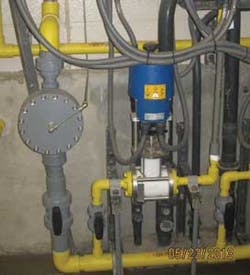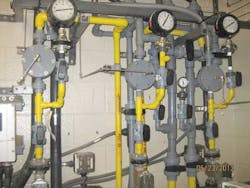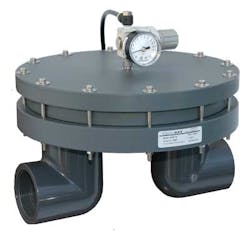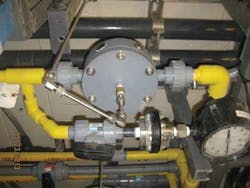A Dose of Precision: Chemical Dosing at AZ Water Treatment Plant Improved by Back Pressure Regulator
By Jeff Jennings
The city of Tempe, Ariz., recently completed a water quality upgrade to its 50-million-gallon-per-day water treatment facility that included an overhaul of its dosing systems for sodium hypochlorite (NaOCl) used to disinfect the water. Like many municipal systems, the original plant used high-maintenance peristaltic metering pumps for the NaOCl dosing. The project replaced the peristaltic pumps with magnetic-drive centrifugal pumps, control valves and magnetic flow meters to lower maintenance costs and improve accuracy.
To address a flow-control issue that was preventing dosing through the full specified range, the city of Tempe partnered with Wilson Engineers of Phoenix to analyze the process. Wilson determined that a more precise back-pressure regulator (BPR) could both stabilize and expand the range of control.
Each centrifugal pump supplies several dosing stations with a constant pressure determined by the BPR installed at the end of the loop. In order to isolate the control valve from the pressure fluctuations in the downstream water main, a BPR is also installed downstream of each control valve. This combination of the two regulators allows the inlet and outlet pressure of the control valve to be held constant. All of the fluid components are manufactured from polymer to resist the highly-corrosive hypochlorite - the active ingredient in household laundry bleach.
The original design incorporated traditional spring-loaded BPRs for each of these applications. However, the pressure sustained by these regulators changed significantly with varying flow rates - as much as 12 to 14 psi deviation at a high flow rate. This pressure build is common with compact spring designs due to the additional force necessary to compress the coil spring as the seat opens.
Like many water systems throughout the country, the Tempe design had a narrow allowable pressure window between the circulating pump output pressure (90 psi) and the downstream water main pressure (up to 80 psi). Further, the spring-operated BPR's unwanted pressure build placed the control valve in a challenging environment: valve differential pressure was maximum at low injection flow rates (challenging low-flow resolution) and was inadequate at maximum injection flow rates (challenging high-end capacity). This limited the range for these injection loops to a range of 3.1 gpm to 6 gpm, which fell short of the required range of 0.7 gpm to 7 gpm.
To address these challenges, Wilson engineer David Highfield and city of Tempe mechanic Brad Hargin contacted Equilibar of Fletcher, N.C., to decide if their precision liquid BPR could provide a more stable environment for the control valve.
Equilibar BPRs incorporate a dome-loaded design and use dozens of parallel orifices sealing on a supple diaphragm to better maintain pressure stability. The dome-loaded design uses compressed air to load the internal diaphragm rather than the coil spring used in traditional designs. The advantage is that the force provided to the diaphragm by the air remains constant regardless of the diaphragm's position as it precisely maintains the liquid pressure.
Equilibar engineer Tony Tang customized 3/4-inch and 1.5-inch regulators with a 110-psig rating while using CPVC body materials, a FKM Viton diaphragm and Van Stone flanges. Precision air pressure regulators were installed to provide constant pilot set-point pressure to the domes of the BPRs.
Highfield's test of the Equilibar in the NaOCl injection system confirmed his theory for improved control. The precision BPR reduced the pressure variability at the control valve outlet by 90 percent to less than 1 psi. The resulting stability allowed the control valve to inject throughout the desired range of 0.7 gpm to 7 gpm.
Dome-loaded BPRs can be adapted to a number of applications, from nano-flows in the research environment up to the 4-inch pipe size, using a wide variety of materials. These more accurate and sensitive designs are not necessary for most industrial applications but can be used where design constraints or additional precision are required.
About the Author: Jeff Jennings, P.E., is founder and president of Equilibar, LLC, a provider of high-precision pressure controls. Prior to Equilibar, he worked as a process development engineer for 23 years. He is a licensed professional engineer in North Carolina and holds several patents. Mr. Jennings can be reached at [email protected] or 828-650-6590.




